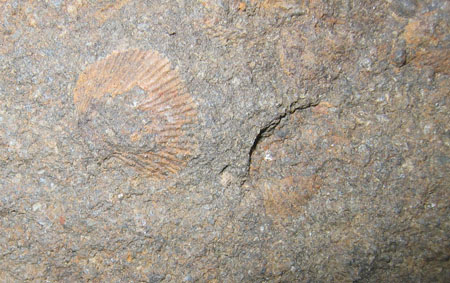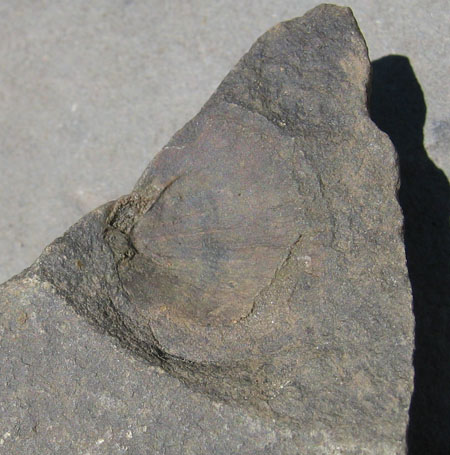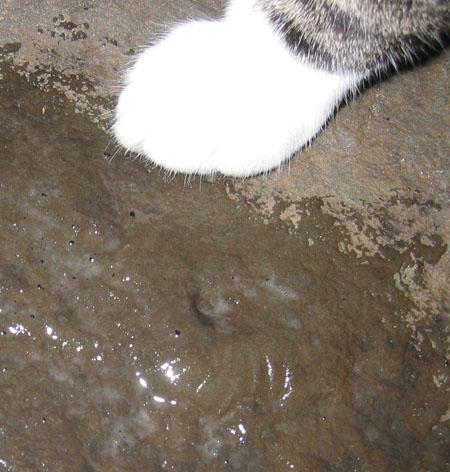|
|
|
fossils in the Chamomile
Wednesday, June 29 2005
Today was a rainy one and I had to wait for a break in the precipitation before taking the dogs for what would normally be their morning walk. I'm working on a new trail that descends gradually down a steep slope (by following an existing deer path that goes at a manageable angle to the contour) to a clearing in the forest near the bus turnaround on Dug Hill Road. Today I used a bow saw to clear fallen trees across the deer path. The air was so humid that my sweat threatened to drown me as I worked. The dogs (and I had three with me because Carlos is visiting again) quickly became exasperated with our lack of movement and eventually Eleanor headed back home, leaving me with just Sally and Carlos.
Eventually their relative patience was rewarded when I took them on a walk through terrain we haven't visited in over a year. We went down to the bus turnaround, where all the trees bear the injuries of years of hillfolk gunfire, and followed the Chamomile back home. Despite recent rains, the bed of the Chamomile was mostly dry, though occasionally there would be a pool and Carlos would splash about in it with enthusiasm in a way that suggested he wanted me to see, "Look, a puddle!" As for me, I was mostly interested in fossils.
For the first couple years of living here I'd never seen fossils and assumed they were very rare or nonexistent. But now that I've handled a lot more rocks in connection with my landscaping projects, I've seen a fair number of fossils, all of them brachiopods. In one rock I found earlier this spring there were three or four perfect brachiopod speciments. Yesterday I found one that was over an inch in diameter. Today while walking up the Chamomile I could see the textures on the rock very clearly because of their dampness from the recent rain. The shinyness through the patterns into high contrast and made fossil spotting much easier than it might otherwise have been. The only handicap was the fact that the rocks I was looking at had all received a light sanding from having spent time in a creekbed, but I was so close to the source of the rocks that many patterns left by fossils would still be apparent. Eventually I found the beautiful (though faint) remnants of some sort of coiled organism, either a trilobite or an ammonite. It was on a six or eight pound rock which I carried all the way home, not easy considering the roughness of the walk (particularly as I passed the downhill neighbor's place - they're great people but three years ago in a view-clearing operation the loggers they hired dumped obscene amounts of branches and trunks directly into the creekbed).

Brachiopods I found earlier in the spring, probably from Englishman's Creek.

A large brachiopod that I found yesterday in Englishman's Creek.

Julius puts his paw near today's trilobite or ammonite. The center of the coil is that sharp depression in the rock.
This evening I was back on one of my favorite sites, ChristianAnswers.net, to remind myself how biblical perfectionists account for the many years that is required for light from distant stars to reach the Earth. In the past I've read Christians explain that God created the light "on the way" from these distant bodies. But ChristianAnswers brings up a good point: what about all the changes to that light that astronomers observe, for example, when a star goes supernova? Why would God put all those fake events into the streams of starlight? As ChristianAnswers points out, that's a lot like saying God put fossils in the rocks to test our faith. Science means nothing at all if the faith-based community can dismiss evidence so easily. So ChristianAnswers posits another solution to this problem, and it's a hoot: Einsteinian Relativity crossed with a Ptolomaic Earth-centered universe. This "theory" posits that the Earth sits at the bottom of a deep gravity well in the center of the universe and that all the billions of years necessary for light to reach us from many stars is provided by the time-compressing effects of General Relativity. It's a pretty wacky idea, and doesn't stand up to much examination, for example: why then don't we see unimaginable blue-shift of the light from not just distant stars, but stars in our own galaxy, which are as much as ten times further away from us than the age of the universe allows light to travel (according to the young-Earth faithful)?
Still, though, I have to hand it to creationists going to such extremes to explain observable phenomena contradicted by the Bible. There might even be something to be gained scientifically by starting with a bunch of absurd axioms and articulating a complete set of theories around them based on observed data. But until such a skunkworks comes up with something genuinely useful, it has no place (for example) being taught in taxpayer-funded classrooms.
For linking purposes this article's URL is:
http://asecular.com/blog.php?050629 feedback
previous | next |


